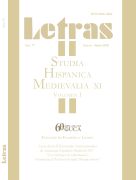All about Lucrecia
Keywords:
Celestina, Lucrecia, Sexual Awakening, Loyalty and TreasonAbstract
This new approach to characterization in the Tragicomedia de Calisto y Melibea is developed through a perception of what its authors surely planned for. The subject is Lucrecia, maid to Melibea, generally thought of as a secondary character inspiring little interest for readers. I believe, to the contrary, that as the constant companion to a libidinous Melibea and her illicit affair with Calisto, but deciding to withhold this information from her employers, Pleberio and Alisa, Lucrecia plays a key role in the resulting tragedies. One result of her role as witness to the passionate lovemaking of the protagonists, Lucrecia herself becomes vividly aware of her own sexuality.Downloads
References
EATON, Katherine, 1973, “The character of Lucrecia in La Celestina”, Annali dell’Istituto Orientali dei Napoli – Sezione Romanza 15, 213-225.
ECHEVERRÍA, Gloria, 1989, “Lucrecia: personaje secundario en la Celestina”, Tesis de Master of Arts, Universidad de Georgia.
MARAVALL, José A., 1964, El mundo social de ‘La Celestina’, Madrid, Gredos.
MARTÍNEZ TORREJÓN, José M., 2005, “‘Apártate allá, Lucrecia’. La violación de Melibea”, en La Celestina 1499-1999, (eds.) Ottavio di Camillo & John O’Neill, New York, Hispanic Seminary of Medieval Studies, pp. 165-187.
OKAMURA, Hajime, 1991, “Lucrecia en el esquema didáctico de Celestina”, Celestinesca 15.1, 53-62.
RANK, Jerry R., 1972, “Awareness and Reaction: The Underlying Elements of Characterization in the Servants of the Celestina”, Kentucky Romance Quarterly 19, 223-236.
RUSSELL, Peter E. (ed.), 2007, La Celestina. Comedia o Tragicomedia de Calisto y Melibea, Madrid, Castalia, Clásicos Castalia 191.
SNOW, Joseph T., 2008, “Las tres primas en el entorno celestinesco y una nota sobre el tema del linaje”, Celestinesca 32, 291-306.
————, 2013, “Confederación e ironía: crónica de una muerte anunciada”, Celestinesca 38, 119-138.
Downloads
Published
How to Cite
Issue
Section
License












